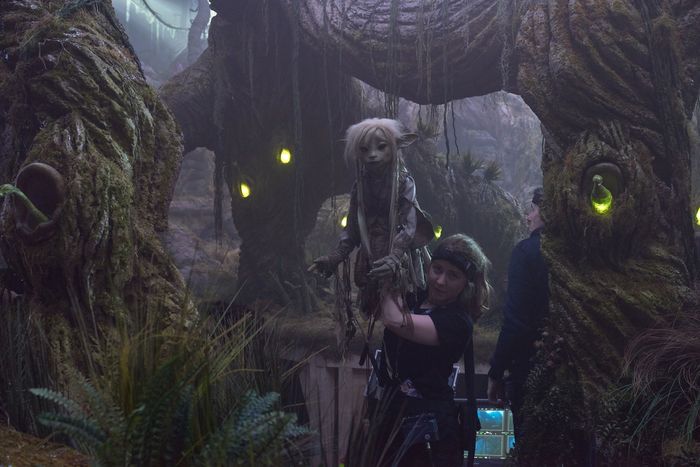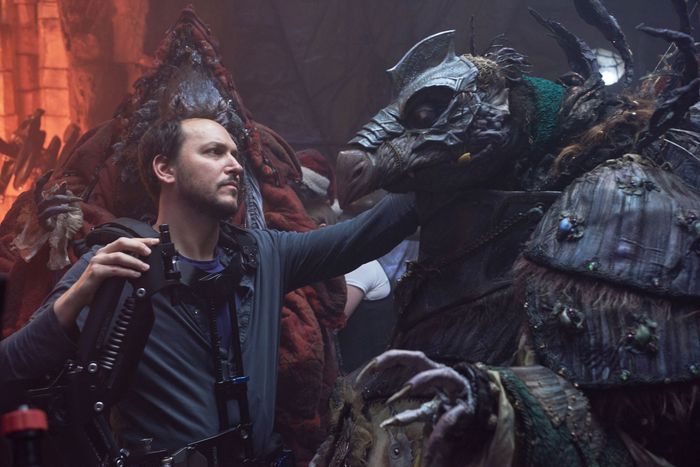
To understand what Dark Crystal: Age of Resistance is, it helps to first understand what it might have been. Watch the informative documentary The Crystal Calls — Making The Dark Crystal: Age of Resistance, which premiered on Netflix alongside the new series, and you’ll receive a striking glimpse of a road not traveled. In a featured scene from a 2016 demo reel, a Skeksi, one of the series’ vulture-like ruling-class villains, menaces a Gelfing, one of its elfin good guys. The Skeksi is a puppet, and its terrifying appearance will look familiar to fans of The Dark Crystal, a 1982 fantasy film directed by Jim Henson and Frank Oz to which the ten-episode Netflix series serves as a prequel. The Gelfling, however, is a CG effect, and while it wouldn’t look out of place in a different sort of fantasy film, it looks all wrong for Thra, the setting of both the Dark Crystal and its prequel. Thra is a world filled with puppets. And filling a world with puppets takes a lot of work, as anyone involved with the project will tell you.
“Louis had never shot puppets,” veteran puppeteer Alice Dinnean says, referring to series director Louis Leterrier, a veteran of action and fantasy films like The Transporter, The Incredible Hulk, and the 2010 remake of Clash of the Titans. “He didn’t know what puppets can’t do. So he just said, ‘This is what the puppets will do.’ And we said, quietly to ourselves, ‘Puppets can’t do that.’” She pauses, then continues. “And then we figured out how to make it happen.”
Leterrier, however, tells the story a little differently. “I actually knew what puppets could do,” he says. “But I didn’t accept it. […] I didn’t accept physics, in a sense. I was like, ‘I know, I know. I understand. But let’s keep going. Let’s go a little bit further.’”
Going a little bit further meant attempting feats never before realized with puppets, while staying true to the vision of the original film, a now-beloved classic that divided critics and met with tepid box office in December of 1982 — though not for a lack of effort on the part of its creators. In advance of the film’s release, Henson and Oz used interviews and TV appearances to prepare audiences for a film featuring no human characters, one darker and stranger than previous projects bearing the Henson name. “The Muppets are performing,” Henson told the New York Times ahead of the film’s release. “These characters are acting.”
The Dark Crystal’s production spanned five years, during which Henson and Oz picked up collaborators like Star Wars co-producer Gary Kurtz and Brian Froud, an English fantasy illustrator most widely known for the best-selling 1978 book Faeries. Henson admired Froud’s ability to create an otherworldly fantasy universe with roots in Froud’s home in picturesque Dartmoor, in southern England. Their collaboration would prove crucial in creating the look of Thra and its inhabitants, most of which bear little resemblance to the cast of The Muppet Show and Sesame Street. Yet for all they achieved, Henson still expressed frustration about the limits he discovered making the film, telling the Times, “These creatures can do very little of what you want them to do. […] They can’t fight, can’t reach over and pick up props. We had to be like magicians, with a whole series of tricks and illusions to fool the audience.”
That the film proved to be a financial disappointment undoubtedly intensified that frustration, but The Dark Crystal began to pick up a cult following almost from the moment it left theaters, thanks to video rentals and cable airings. Not that its creators could have known this at the time.
“No, we didn’t know,” Froud replies when asked if they anticipated its second life. “Obviously we were disappointed, but in many ways we made the film we wanted to see, as the creators. It was of an age when things weren’t so focused on who it was for. It always felt like we made a film everybody would want to watch.”
Froud met his wife Wendy Froud, an artist, designer, and sculptor who helped create the look of Yoda for Empire Strikes Back, while working on The Dark Crystal. A few years later, their son Toby served as the toddler kidnapped by David Bowie in the 1986 film Labyrinth, another collaboration with Henson. Now an artist, filmmaker, animator, designer, and effects specialist, whose credits include extensive work with the stop-motion studio Laika, Toby talks about taking up the family business as an inevitability. “I feel like I was born into it,” Toby says with a laugh. “I’ve always created puppets and costumes and my aesthetic sort just came naturally back to the Froudian field that my father and mother created.”
That they’d end up working together on a revival of The Dark Crystal, as they did on Age of Resistance, now looks almost as preordained. But making that family collaboration possible required a few false starts. In 2006, the Jim Henson Company CEO Lisa Henson, daughter of Jim, announced Power of the Dark Crystal, a sequel to be directed by acclaimed animator Genndy Tartakovsky, creator of Samurai Jack. “I learned my lesson,” Lisa Henson says, reflecting on the project. “Don’t ever talk about something at Comic Con unless you actually have the money to make it. Because the fans were very disappointed in us.”
After that project failed to launch, other ideas for sequels and prequels followed, as did a collaboration with Leterrier, who made plans to direct a new Dark Crystal feature film. Instead, thanks to Netflix’s interest in a series made in the style of the original film, they created the ten-episode prequel, Age of Resistance.
This, of course, involved crafting a profusion of puppets ranging from the massive Skeksi to the tiny Podlings (the most Muppet-y residents of Thra), to arachnid-like creatures that offered few opportunities to hide those operating them. The project also demanded developing new approaches to performance, as Dinnean discovered while bringing to life Brea, one of the series’ protagonists, via a combination of old-fashioned puppetry and on-the-fly modifications of modern technology.
“I had a new type of performance with Brea where I had my own animatronic input device that I carried around with me,” Dinnean says. “I actually had a tiny computer that I wore on a belt with a battery, basically just a motherboard. They had hacked a video-game controller to go into this little motherboard and then back out came the cables that run the servos for Brea’s eye blinks and eye movement. So I didn’t have any control over her hands most of the time because my right hand was in her head and mouth and my left hand was running blinks and eye movement, which was great because I can sync those two things together. […] But there were times that I took my little input device and I just taped it to my arm rod and I had the hands as well. But that’s ’cause I’m a control freak.”
What’s more, Dinnean and the other puppeteers had to pull this off while watching their performances in monitors, the only way to see their puppets and play off the performances of the other puppeteers. “These characters, when they look at something, when they move through space, it’s entirely an illusion,” Dinnean says. “It’s a magic trick. Oftentimes, if you look at them in real space, they’re not looking at each other at all. Which is why it’s hard to shoot two cameras at once on puppets. They could be looking directly past each other and it’s quite obvious from one angle. [But] from the camera’s angle, it looks like they’re staring right into each other’s eyes.”
Such complications required Leterrier, who also served as a camera operator alongside director of photography Erik Alexander Wilson, to make some adjustments as well, yet the dynamic camerawork recalls the director’s human-populated features. “I sort of retrofitted my camera and my camerawork and my tools to make it work for puppets. […] It has to be puppets, 100 percent puppets, but you have to forget you’re watching puppets. I cannot do the typical puppet trick of having a foreground piece that always hides the bottom half of the body.” To sell the illusion, he relied on some old-fashioned bits of movie magic. “There were normal techniques, funny techniques, little old techniques,” Leterrier says. “The old stuff that you see in movies, [like] a stuntman rolling down and then up stands the actor.”
That doesn’t mean 21st-century technology didn’t play a part as well. Puppets dominate Dark Crystal: Age of Resistance, but it does feature some CG enhancements. “Sometimes something of a certain size would become CG, whether it was very tiny or very big,” Henson says. The most common use of CG, however, came via the use of green screen, which allowed the series to open up its world. “CG was used with parsimony to enhance the world, to widen the world up a little bit,” Leterrier confirms. “We had to shoot everything on a stage and we had a stage that was a little short. Sometimes we had to extend the sky. That’s what CG was used for. It was never used to replace anything.”
By allowing for the erasure of puppeteers, green screen also proved useful in creating puppet characters that couldn’t be realized in the original film, like Lore, a pile of animated rocks that has a special place in Brian Froud’s heart. “The shapes and form of that character are precisely what Jim Henson saw when he first came to the landscape I live in so many years ago,” he says. “I’m absolutely delighted we’ve created a character not only true to the spirit of the original film but true to the spirit of Jim Henson.” As for the role green screen plays in making Lore come to life, he sees it as a high-tech form of a trick borrowed from Japanese bunraku puppetry, in which puppeteers make themselves invisible by performing against a black backdrop while wearing black robes.
Yet as easy as it is to explain how the puppets work, why they work remains something of a mystery, even to Brian Froud. “I think there’s something primal about human beings and our desire to invest the inanimate with life, especially things that we assemble and try to give our personality,” he says. “Our rational mind tells us it’s just made out of stuff but our emotional body responds to something that seems to move and has a life beyond itself. There is something extraordinary, especially when watching the new series … You don’t lose sight, ever, that they are puppets, but then they’ll do something that catches you unawares because it’s emotional. And it becomes a magical thing.”



